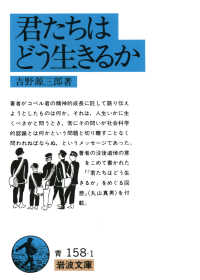- ホーム
- > 洋書
- > 英文書
- > Politics / International Relations
Full Description
Insightful and engaging, this is the most complete guide to the past, present, and future of the European Union. An expert author team examines in detail the theory and history behind the EU, before moving on to explore the institutions and policies at work, giving readers valuable insight into this complicated political body.
Key Features:
- An accessible yet thorough guide to the history, theory, institutions, and policies of the European Union, ideal for undergraduates and postgraduates studying the European Union for the first time.
- An expert author team uses clear, straightforward language to ensure that students fully understand the complex functions of the EU.
- Features four chapters dedicated to theory, each including a range of examples of the practical workings of the EU to help you apply theoretical perspectives to the real world of politics.
New to this edition:
- A new section (Part Five: Challenges and Prospects) includes a new chapter, Chapter 25, which reflects on the state of the contemporary EU following Russia's invasion of Ukraine and the re-election of Donald Trump to the US presidency.
- The history chapters have been re-organized, and Chapter 9 on recent crises has been updated to include developments such as the Covid-19 pandemic and the Russian invasion of Ukraine.
- A new history chapter, Chapter 10, considers the main historical drivers of European integration.
- The theory section has been refreshed - in particular, new material in Chapter 4 on post-colonial perspectives.
- The institutions chapters have been updated to reflect the European Parliament elected in 2024 and the reappointment of Ursula von der Leyen as Commission President.
- The policy section includes new insight boxes throughout on contemporary themes and issues.
Digital formats and resources
The sixth edition is available for students and institutions to purchase in a variety of formats: the e-book and Politics Trove offer a mobile experience and convenient access along with self-test questions, functionality tools, navigation features and links that offer extra learning support. For more information about e-books, please visit www.oxfordtextbooks.co.uk/ebooks
Contents
Part 1: Theory
1: Theories of European Integration
2: Theories of EU Governance
3: Theorizing Consequences
4: Critical Perspectives
Part 2: History
5: Initiating European Integration: 1945-51
6: Developing the European Communities: 1952-68
7: The Road to the European Union: 1969-1991
8: From Maastricht to the Lisbon Treaty: 1992-2009
9: The EU 'Polycrisis': 2010-24
10: History, Dynamics and Characteristics
Part 3: Institutions
11: The Institutional Architecture
12: The European Commission
13: The European Council and the Council of the European Union (EU)
14: The European Parliament
15: The Court of Justice of the European Union
16: Organized Interests
Part 4: Policies
17: Policy Making and Policies in the European Union
18: The Single Market
19: Economic and Monetary Union
20: Agriculture
21: Environment and Climate
22: Freedom, Security and Justice
23: Trade and Development Aid
24: Common Foreign and Security Policy
Part 5: Challenges and Prospects
25: The State of the EU: Fit for the Future?








